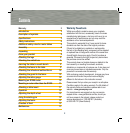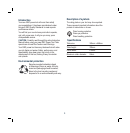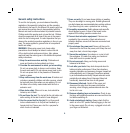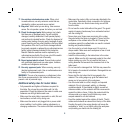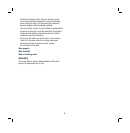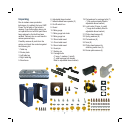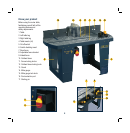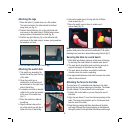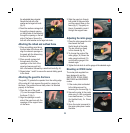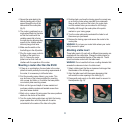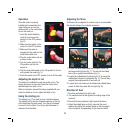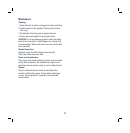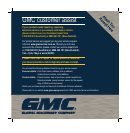
5
17. Use outdoor rated extension cords.
When a tool
is used outdoors, use only extension cords that are
intended for outdoor use and are so marked.
18. Stay alert. Watch what you are doing. Use common
sense. Do not operate a power tool when you are tired.
19. Check for damaged parts. Before using a tool, check
that there are no damaged parts. If a part is slightly
damaged, carefully determine if it will operate properly
and perform its intended function. Check for alignment of
moving parts, binding of moving parts, breakage of parts,
proper mounting and any other conditions that may affect
the operation of the tool. A part that is damaged should
be properly repaired or replaced by an authorised service
facility, unless otherwise indicated in this Instruction
Manual. Defective switches must be replaced by an
authorised service facility. Do not use a tool if the switch
does not turn the tool on and off correctly.
20. Guard against electric shock. Prevent body contact
with grounded objects such as water pipes, radiators,
cookers and refrigerator enclosures.
21. Use only approved parts. When servicing, use only
identical replacement parts. Use an authorised service
facility to fit replacement parts.
WARNING. The use of an accessory or attachment, other
than those recommended in this Instruction Manual, may
present a risk of personal injury.
Additional safety rules for router tables
• Fully assemble and tighten all fasteners required for
this table. Do not use the router table until it is fully
assembled. Check the table and the router to make sure
fasteners are still tight before each use.
• Make sure the router table is secured to a solid, flat and
level surface, and will not tip during use.
• Make sure the router is not plugged into a power outlet
when installing it on the table, making adjustments, or
changing accessories. The router could start accidentally.
• Make sure the router is fully and securely attached to the
router table. Periodically check connections for tightness.
The router motor can vibrate loose during use and fall
from the table.
• Do not use the router table without the guard. The guard
assists in keeping hands away from unintended contact
with the rotating bit.
• Never place your fingers near a spinning bit or under
the guard when the router is plugged in. Never hold the
workpiece on the outfeed side of the bit. Pressing the
workpiece against the outfeed side can result in material
binding and possible kickback.
• Use the router to cut and shape wood. Do not cut or
shape metals. Make sure each workpiece is free of nails
and other obstructions.
• Install the bit according to the instructions in the router
manual. Make sure the bit is securely sealed in the collet
before making any cuts. Do not use bits that have a
cutting diameter that exceeds the clearance hole in the
table insert.
• Do not use dull or damaged bits. Dull bits may cause the
bit to break or the material to kickback. Damaged bits can
snap during use.
• Never start the tool when the bit is engaged in the
material. The cutting edge may grab the material and
cause you to lose control of the workpiece.
• Use the router table to cut flat, straight, and squared
materials. Do not cut warped, wobbly, or otherwise
unstable material. If the material is slightly curved but
otherwise stable, cut the material with the concave side
against the table or fence. Cutting the material with the
concave side up or away from the table may cause
warped material to roll and kickback.
• Feed the material against the rotation of the bit. The bit
rotates anti-clockwise as viewed from the top of the table.
Feeding the work in the wrong direction will cause the
workpiece to “climb” up on the bit pulling the workpiece
and possibly your hands into the rotating bit.




